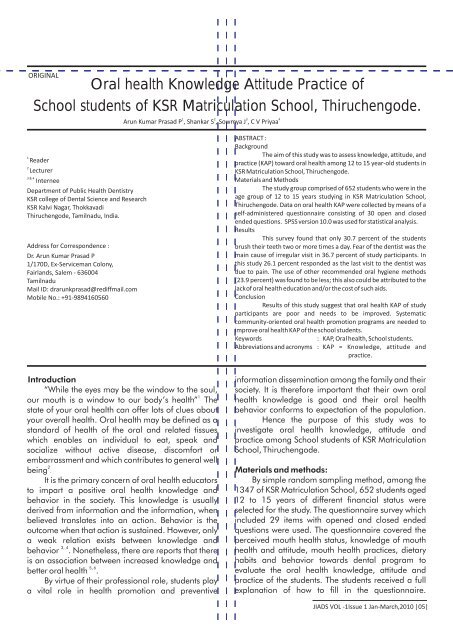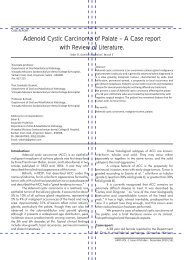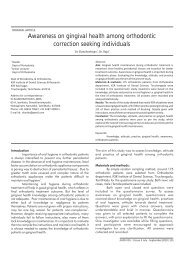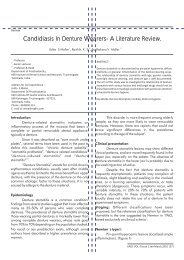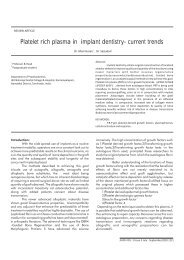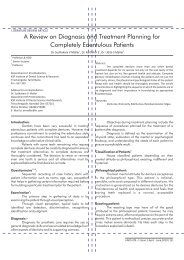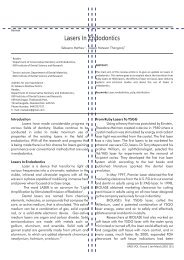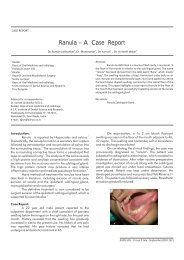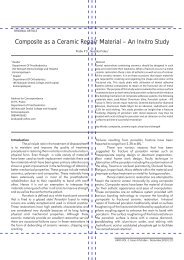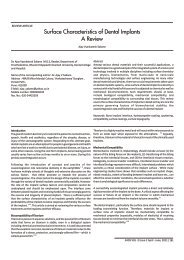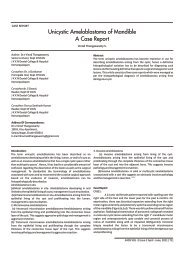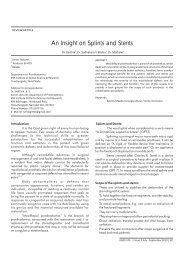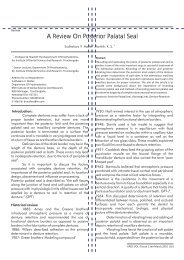Oral health Knowledge Attitude Practice of School students of KSR ...
Oral health Knowledge Attitude Practice of School students of KSR ...
Oral health Knowledge Attitude Practice of School students of KSR ...
You also want an ePaper? Increase the reach of your titles
YUMPU automatically turns print PDFs into web optimized ePapers that Google loves.
ORIGINAL<br />
<strong>Oral</strong> <strong>health</strong> <strong>Knowledge</strong> <strong>Attitude</strong> <strong>Practice</strong> <strong>of</strong><br />
<strong>School</strong> <strong>students</strong> <strong>of</strong> <strong>KSR</strong> Matriculation <strong>School</strong>, Thiruchengode.<br />
1 2 3 4<br />
Arun Kumar Prasad P , Shankar S , Sowmya J , C V Priyaa<br />
1<br />
Reader<br />
2<br />
Lecturer<br />
3 & 4<br />
Internee<br />
Department <strong>of</strong> Public Health Dentistry<br />
<strong>KSR</strong> college <strong>of</strong> Dental Science and Research<br />
<strong>KSR</strong> Kalvi Nagar, Thokkavadi<br />
Thiruchengode, Tamilnadu, India.<br />
Address for Correspondence :<br />
Dr. Arun Kumar Prasad P<br />
1/170D, Ex-Serviceman Colony,<br />
Fairlands, Salem - 636004<br />
Tamilnadu<br />
Mail ID: drarunkprasad@rediffmail.com<br />
Mobile No.: +91-9894160560<br />
ABSTRACT :<br />
Background<br />
The aim <strong>of</strong> this study was to assess knowledge, attitude, and<br />
practice (KAP) toward oral <strong>health</strong> among 12 to 15 year-old <strong>students</strong> in<br />
<strong>KSR</strong> Matriculation <strong>School</strong>, Thiruchengode.<br />
Materials and Methods<br />
The study group comprised <strong>of</strong> 652 <strong>students</strong> who were in the<br />
age group <strong>of</strong> 12 to 15 years studying in <strong>KSR</strong> Matriculation <strong>School</strong>,<br />
Thiruchengode. Data on oral <strong>health</strong> KAP were collected by means <strong>of</strong> a<br />
self-administered questionnaire consisting <strong>of</strong> 30 open and closed<br />
ended questions. SPSS version 10.0 was used for statistical analysis.<br />
Results<br />
This survey found that only 30.7 percent <strong>of</strong> the <strong>students</strong><br />
brush their teeth two or more times a day. Fear <strong>of</strong> the dentist was the<br />
main cause <strong>of</strong> irregular visit in 36.7 percent <strong>of</strong> study participants. In<br />
this study 26.1 percent responded as the last visit to the dentist was<br />
due to pain. The use <strong>of</strong> other recommended oral hygiene methods<br />
(23.9 percent) wasfound to be less; this also could be attributed to the<br />
lack<strong>of</strong> oral <strong>health</strong> education and/or the cost <strong>of</strong> such aids.<br />
Conclusion<br />
Results <strong>of</strong> this study suggest that oral <strong>health</strong> KAP <strong>of</strong> study<br />
participants are poor and needs to be improved. Systematic<br />
community-oriented oral <strong>health</strong> promotion programs are needed to<br />
improve oral <strong>health</strong> KAP <strong>of</strong> the school <strong>students</strong>.<br />
Keywords<br />
: KAP, <strong>Oral</strong> <strong>health</strong>, <strong>School</strong> <strong>students</strong>.<br />
Abbreviations and acronyms : KAP = <strong>Knowledge</strong>, attitude and<br />
practice.<br />
Introduction<br />
“While the eyes may be the window to the soul,<br />
1<br />
our mouth is a window to our body’s <strong>health</strong>”<br />
.<br />
The<br />
state <strong>of</strong> your oral <strong>health</strong> can <strong>of</strong>fer lots <strong>of</strong> clues about<br />
your overall <strong>health</strong>. <strong>Oral</strong> <strong>health</strong> may be defined as a<br />
standard <strong>of</strong> <strong>health</strong> <strong>of</strong> the oral and related tissues<br />
which enables an individual to eat, speak and<br />
socialize without active disease, discomfort or<br />
embarrassment and which contributes to general well<br />
2<br />
being .<br />
It is the primary concern <strong>of</strong> oral <strong>health</strong> educators<br />
to impart a positive oral <strong>health</strong> knowledge and<br />
behavior in the society. This knowledge is usually<br />
derived from information and the information, when<br />
believed translates into an action. Behavior is the<br />
outcome when that action is sustained. However, only<br />
a weak relation exists between knowledge and<br />
3, 4<br />
behavior . Nonetheless, there are reports that there<br />
is an association between increased knowledge and<br />
5, 6<br />
better oral <strong>health</strong> .<br />
By virtue <strong>of</strong> their pr<strong>of</strong>essional role, <strong>students</strong> play<br />
a vital role in <strong>health</strong> promotion and preventive<br />
information dissemination among the family and their<br />
society. It is therefore important that their own oral<br />
<strong>health</strong> knowledge is good and their oral <strong>health</strong><br />
behavior conforms to expectation <strong>of</strong> the population.<br />
Hence the purpose <strong>of</strong> this study was to<br />
investigate oral <strong>health</strong> knowledge, attitude and<br />
practice among <strong>School</strong> <strong>students</strong> <strong>of</strong> <strong>KSR</strong> Matriculation<br />
<strong>School</strong>, Thiruchengode.<br />
Materials and methods:<br />
By simple random sampling method, among the<br />
1347 <strong>of</strong> <strong>KSR</strong> Matriculation <strong>School</strong>, 652 <strong>students</strong> aged<br />
12 to 15 years <strong>of</strong> different financial status were<br />
selected for the study. The questionnaire survey which<br />
included 29 items with opened and closed ended<br />
questions were used. The questionnaire covered the<br />
perceived mouth <strong>health</strong> status, knowledge <strong>of</strong> mouth<br />
<strong>health</strong> and attitude, mouth <strong>health</strong> practices, dietary<br />
habits and behavior towards dental program to<br />
evaluate the oral <strong>health</strong> knowledge, attitude and<br />
practice <strong>of</strong> the <strong>students</strong>. The <strong>students</strong> received a full<br />
explanation <strong>of</strong> how to fill in the questionnaire.<br />
JIADS VOL -1Issue 1 Jan-March,2010 |05|
<strong>Oral</strong> <strong>health</strong> <strong>Knowledge</strong> <strong>Attitude</strong> <strong>Practice</strong><br />
Arun Kumar Prasad & Shankar<br />
Furthermore, the investigator was always available<br />
during the completion <strong>of</strong> the questionnaire and the<br />
participants were encouraged to approach the<br />
investigator, whenever they needed to clarify at any<br />
point.<br />
Data analysis<br />
The data was analyzed using the SPSS version<br />
10.0 s<strong>of</strong>tware. The individual scores were summed up<br />
to yield a total score and given in subtitles for each<br />
questions. Frequency distribution, number and<br />
percentage were calculated.<br />
Results<br />
This study was conducted to assess oral <strong>health</strong><br />
KAP among 12 – 15 years old 652 <strong>School</strong> <strong>students</strong> <strong>of</strong><br />
<strong>KSR</strong> Matriculation <strong>School</strong>, Thiruchengode. Age and<br />
gender distribution <strong>of</strong> the respondents were given in<br />
figure 1 and 2 respectively. Their fathers and mothers<br />
education were given in figure 3 and 4 respectively.<br />
The questionnaire results were split up into five<br />
sections as perceived mouth <strong>health</strong> status, knowledge<br />
<strong>of</strong> mouth <strong>health</strong> and attitude, mouth <strong>health</strong> practices,<br />
dietary habits and behavior towards dental problem<br />
and given in the tables 1 – 5 respectively.<br />
Discussion<br />
This study assessed oral <strong>health</strong> attitudes,<br />
knowledge, and practice <strong>of</strong> <strong>School</strong> <strong>students</strong> <strong>of</strong> <strong>KSR</strong><br />
Matriculation <strong>School</strong>, Thiruchengode. In the present<br />
study, the participants in the age group <strong>of</strong> 12-15 years<br />
were selected by simple random sampling method.<br />
The data were collected by means <strong>of</strong> structured<br />
questionnaires.<br />
In this study, it was also found that 1.8 percent <strong>of</strong><br />
fathers <strong>of</strong> study participants were illiterate (fig 3), while<br />
it was 3.5 percent for mothers (fig 4) which is<br />
significantly less when compared to other occupation.<br />
The present study cannot be exactly compared with<br />
the other studies but careful observations can be<br />
made with the other studies.<br />
Table 1. Perceived mouth <strong>health</strong> status<br />
JIADS VOL -1Issue 1 Jan-March,2010 |06|
<strong>Oral</strong> <strong>health</strong> <strong>Knowledge</strong> <strong>Attitude</strong> <strong>Practice</strong><br />
Arun Kumar Prasad & Shankar<br />
Table 2. <strong>Knowledge</strong> <strong>of</strong> mouth <strong>health</strong> and attitude<br />
Table 3. Mouth <strong>health</strong> practices<br />
JIADS VOL -1Issue 1 Jan-March,2010 |07|
<strong>Oral</strong> <strong>health</strong> <strong>Knowledge</strong> <strong>Attitude</strong> <strong>Practice</strong><br />
Arun Kumar Prasad & Shankar<br />
Tabel 4. Dietary habits<br />
Table 5. Behaviour towards dental problem<br />
JIADS VOL -1Issue 1 Jan-March,2010 |08|
<strong>Oral</strong> <strong>health</strong> <strong>Knowledge</strong> <strong>Attitude</strong> <strong>Practice</strong><br />
Arun Kumar Prasad & Shankar<br />
Figure 1. Age distribution <strong>of</strong> the respondents<br />
Figure 3. Distribution <strong>of</strong> father's education<br />
<strong>of</strong> the respondents<br />
Figure 2. Gender distribution <strong>of</strong> the respondents<br />
Figure 4. Distribution <strong>of</strong> mother's education<br />
<strong>of</strong> the respondents<br />
Perceived oral <strong>health</strong> status<br />
2.1 <strong>of</strong> percent the participants considered their<br />
oral <strong>health</strong> status was poor which was very less when<br />
compared to a previous study by Benoit Varenne et al 7<br />
where it was 63 percent and it indicates that the<br />
present study respondents does not really understand<br />
what constitutes the oral <strong>health</strong> status. In this study the<br />
57.7 percent agreed that regular brushing prevents<br />
all tooth problems, 24.2 percent disagreed and 17<br />
percent don’t even know about that which indicates<br />
poor knowledge on their perception <strong>of</strong> oral <strong>health</strong>.<br />
<strong>Oral</strong> <strong>health</strong> knowledge and attitude<br />
Awareness <strong>of</strong> the importance <strong>of</strong> tooth brushing<br />
for caries prevention was high (57.7 percent) among<br />
the study population. This finding is similar to study by<br />
7<br />
Varenne et al., where majority <strong>of</strong> children in urban<br />
areas reported that tooth cleaning and regular dental<br />
visits may prevent oral disease.<br />
<strong>Oral</strong> <strong>health</strong> practices<br />
This survey found that only 30.7 percent brushed<br />
their teeth two or more times a day, but in a study by<br />
8<br />
Zhu et al. it was 44.4 percent. In the present study<br />
subjects reported irregular times <strong>of</strong> tooth brushing as<br />
1.2 percent once in a week and 5 percent as never<br />
9<br />
brush their teeth similar to study by Al-Omiri et al . The<br />
use <strong>of</strong> other recommended oral hygiene methods<br />
(23.9 percent) wasfound to be less; this also could be<br />
attributed to the lack <strong>of</strong> oral <strong>health</strong> education and/or<br />
the cost <strong>of</strong> such aids. In contrast, Hamilton and<br />
10<br />
Coulby found that a high percentage [44 percent] <strong>of</strong><br />
the sample they studied in north eastern Ontario used<br />
dental floss, reason for this may be because<br />
significant resource allocation to <strong>health</strong> education<br />
programs are carried out.<br />
JIADS VOL -1Issue 1 Jan-March,2010 |09|
<strong>Oral</strong> <strong>health</strong> <strong>Knowledge</strong> <strong>Attitude</strong> <strong>Practice</strong><br />
Arun Kumar Prasad & Shankar<br />
In the present study, it was found that female<br />
performance was better than male performance in<br />
oral <strong>health</strong> practices which was similar to study by El-<br />
11<br />
Qaderi and Taani . Females performed the oral<br />
hygiene practices better than their male counterpart<br />
12<br />
which is in agreement with other previous studies .<br />
This difference can attributed to a higher concern<br />
regarding personal hygiene and <strong>health</strong> care among<br />
females.<br />
Behavior (practice) toward dental problems<br />
Students had positive attitudes toward their<br />
dentists; nevertheless, they indicated that they feared<br />
dental treatment. Fear <strong>of</strong> the dentist was the main<br />
cause <strong>of</strong> irregular visit in 36.7 percent <strong>of</strong> study<br />
participants which was very high compared to study by<br />
11<br />
El-Qaderi and Taani et al. In the present study, the<br />
participants were mainly from lower socioeconomic<br />
strata. It can also be considered that because <strong>of</strong> the<br />
high cost <strong>of</strong> dental treatment may have limited the<br />
accessibility <strong>of</strong> dental care.<br />
In this study 26.1 percent responded as the last<br />
visit to the dentist was due to pain, 26.1 percent<br />
responded as regular visit and 43.9 percent by others<br />
motivation. Though high percentage <strong>of</strong> study<br />
participants had pain from teeth (59.7 percent) during<br />
past 12 months, their dental visits were infrequent and<br />
it was similar to the study by Varenne et al (35.1<br />
7<br />
percent) . In contrast to this, in the studies by Petersen<br />
13 14<br />
et al. [66 percent] and Wierzbicka et al., [61<br />
percent], a high percentage <strong>of</strong> the study participants<br />
claimed annual dental visit.<br />
Dietary habits<br />
In the present study 33.7 percent and 27.9<br />
percent consume sweet and s<strong>of</strong>t drinks at least once in<br />
a day respectively. In the study by Harikiren et al high<br />
proportion <strong>of</strong> study participants reported having<br />
hidden sugar every day: s<strong>of</strong>t drinks (32.1 percent),<br />
milk with sugar (65.9 percent), and tea with sugar<br />
(56.1 percent) and it was very high compared to study<br />
12<br />
by Petersen et al.<br />
Based upon the present study findings, oral<br />
<strong>health</strong> KAP <strong>of</strong> the surveyed <strong>students</strong> were poor. This<br />
poor oral <strong>health</strong>-related KAP have to be addressed<br />
and focused upon as an important component <strong>of</strong> any<br />
comprehensive oral <strong>health</strong> program.<br />
Results <strong>of</strong> this study suggest that oral <strong>health</strong><br />
related KAP <strong>of</strong> the study participants are poor and<br />
needs to be improved. Systematic communityoriented<br />
oral <strong>health</strong> promotion programs are needed<br />
to improve oral <strong>health</strong> KAP <strong>of</strong> <strong>students</strong>. Inclusion <strong>of</strong><br />
more oral <strong>health</strong> orientation program in their<br />
curriculum would improve further, their oral <strong>health</strong><br />
behavior and knowledge, so as to be a good model to<br />
the community.<br />
References<br />
1. h t t p : / / w w w. w m . e d u / o f f i c e s / h r /<br />
benefits / c o m m o n h e a l t h / o r a l h e a l t h /<br />
index.php. Accessed on 09.01.2010<br />
2. Department <strong>of</strong> <strong>health</strong>. An oral <strong>health</strong> strategy for<br />
England, London: dept. <strong>of</strong> <strong>health</strong>, 1994.<br />
3. Freeman R, Maizels J, Wylir M, Sheiham A. The<br />
relationship between <strong>health</strong> related knowledge,<br />
attitudes and dental <strong>health</strong> behavior in 14-16 year old<br />
adolescents. Community Dent Health 193; 10:397-404.<br />
4. Kay EJ, Locker D. Asystematic review <strong>of</strong> the effectiveness<br />
<strong>of</strong> <strong>health</strong> promotion aimed at improving oral <strong>health</strong>.<br />
Community Dent <strong>Oral</strong> Epidemiol 1998; 26:132-144.<br />
5. Woodgroove J, Cumberbatch G, Gylbier S.<br />
Understanding dental attendance behaviour.<br />
Community Dent Health 1987; 4:215-221.<br />
6. Hamilton ME, Coulby WM. <strong>Oral</strong> <strong>health</strong> knowledge and<br />
habits <strong>of</strong> senior elementary school <strong>students</strong>. J <strong>of</strong> Public<br />
Health Dent 1991; 51:212-218.<br />
7. Varenne B, Petersen PE, Ouattara S. <strong>Oral</strong> <strong>health</strong><br />
behaviour <strong>of</strong> children and adults in urban and rural<br />
areas <strong>of</strong> Burkina Faso, Africa. Int Dent J 2006; 56:61-70.<br />
8. Zhu L, Petersen PE, Wang HY, Bian JY, Zhang BX. O r a l<br />
<strong>health</strong> knowledge, attitudes and behaviour <strong>of</strong> adults in<br />
China. Int Dent J 2005; 55:231-41. 9. Al-Omiri MK, Al-<br />
Wahadni AM, Saeed KN. <strong>Oral</strong> h e a l t h a t t i t u d e s ,<br />
knowledge, and behavior among school children in North<br />
Jordan: J Dent Educ 2006; 70:179-87.<br />
10. Hamilton ME, Coulby WM. <strong>Oral</strong> <strong>health</strong> knowledge and<br />
habits <strong>of</strong> senior elementary school <strong>students</strong>. J Public<br />
Health Dent 1991; 51:212-9.<br />
11. El-Qaderi SS, Taani DQ. <strong>Oral</strong> <strong>health</strong> knowledge a n d<br />
dental <strong>health</strong> practices among school children in Jerash<br />
district-Jordan. Int J Dent Hyg 2004; 2:78-85.<br />
JIADS VOL -1Issue 1 Jan-March,2010 |10|
<strong>Oral</strong> <strong>health</strong> <strong>Knowledge</strong> <strong>Attitude</strong> <strong>Practice</strong><br />
Arun Kumar Prasad & Shankar<br />
12. Beiruti N, Boles D, Poulsen S. <strong>Oral</strong> <strong>health</strong> knowledge and<br />
behaviour <strong>of</strong> a group <strong>of</strong> 15-year old school children from<br />
Damscus, Syria. Int J Paediatr Dent 1995; 5:187-8.<br />
13. Petersen PE, Hoerup N, Poomviset N, Prommajan<br />
J, Watanapa A. <strong>Oral</strong> <strong>health</strong> status and oral <strong>health</strong><br />
behaviour <strong>of</strong> urban and rural schoolchildren in Southern<br />
Thailand. Int Dent J 2001; 51:95-102.<br />
14. Wierzbicka M, Petersen PE, Szatko F, Dybizbanska<br />
E, Kalo I. Changing oral <strong>health</strong> status and oral <strong>health</strong><br />
behaviour <strong>of</strong> schoolchildren in Poland. Community Dent<br />
Health 2002; 19:243-50.<br />
JIADS VOL -1Issue 1 Jan-March,2010 |11|


